ASRock A75 Extreme6 Review and Desktop Llano Overclocking
by Ian Cutress on June 30, 2011 12:05 AM ESTBIOS
Desktop Llano gets a taste of ASRock's full graphical UEFI, which we've seen a couple of times before on P67 and H67. There's not much new to discuss over the previous versions, except for the Llano specific features, an error I found regarding memory compatibility.
As any motherboard manufacturer will tell you, in order to be the best you have to win on performance. To do this, you need to have your default settings in a rather uncomfortable zone - in terms of the CPU, if your base clock is 100.4 MHz rather than 100.0 MHz, you could gain an advantage. The same thing applies to memory - if by default your timings are the tightest they can possibly be, then you'll be ahead of the competition. The issue is when your timings are too tight, and the BIOS isn't equipped to deal with this issue properly. I've been testing with G.Skill's DDR3-1866 MHz kit which comes in the form of 4x4 GB sticks. When trying to boot, about 80% of the time, I'd get a random error code on ASRock's Debug LED. I mentioned this to ASRock, who suggested I loosen the tRCD when I could get into the BIOS. This had no effect; neither did applying the XMP settings. I tried with two 4GB sticks, to determine if this was a kit compatibility issue or a 16GB compatibility issue, and it turns out it is kit specific. ASRock are aware of this problem (and have access to the exact same kit I was using and also acknowledge the issue), so I will assume that in the near future a BIOS update will be released. Addendum: This should be fixed in the 11I BIOS.
Note: We were told a little while back that Llano has had some issues with very old Hynix memory. This G.Skill kit does use Hynix, but the newer stuff which should not have an issue with a fixed BIOS behind it.
As with any BIOS, I find having an initial screen with a lot of relevant data is key. ASUS are the winners so far, but ASRock does quite well with CPU and DRAM data. Perhaps future versions will add voltages, temperatures and fan speeds to this initial page:
The main difference in Llano to other BIOS is going to be in the overclocking screens. I'll be going into detail as to how Llano overclocks later on, but on this ASRock board, we have a lot of options. In terms of overclocking modes, there are three - manual, 'CPU OC Mode' or 'DRAM OC Mode'. In the CPU and DRAM OC mode, a drop down menu underneath would appear, allowing you to select predefined values, and when one of these was selected, the APU speed would be adjusted accordingly in the settings underneath. CPU Mode gives the options to OC from 3200 MHz to 3600 MHz on our APU, whereas DRAM Mode offers DDR3-2000 to 2500 MHz(!). You cannot select both modes at the same time, though you can make note of the settings and implement them in manual mode.
In manual mode, we can select the APU frequency in 1 MHz jumps, and an odd function called 'dynamic overclocking', which gives the option to add an additional percentage overclock on top of your APU overclock when the system is under load. Also present is the option to enable/disable Turbo Core, but on this APU (A8-3850) there is no Turbo Core, so the option does nothing (even if it does give an option to up the multiplier to 33x).
The BIOS also gives the option to change multiplier - anything above 29x on this APU, while it gives a new value for processor frequency in CPU-Z in the OS, doesn't actually do anything - such is the Llano limitation. But you can select underneath 29x to declock the system. Also interesting is that the CPU NB Frequency can be directly adjusted - while the BIOS says 'Multiplier', the values offered are given in MHz - from 654 MHz to 1054 MHz. This is different to the iGPU frequency overclock, which has its own option from 626 MHz to 1800 MHz, also with a voltage change.
The standard array of memory sub-timing options are also here, including to set XMP profiles. Up to three BIOS profiles can be saved.
In terms of BIOS based fan controls, the H/W Monitor option has our fan settings. The PWR header cannot be controlled, and both CPU fan headers are controlled through one setting. The other fan settings can be set as 'Manual', where a fan speed between 'Level 1' and 'Level 9' can be chosen. In Automatic mode, a target CPU temperature and a fan speed setting can be selected.
Software
The ASRock software package has not changed much recently since our last reviews on ASRock's P67 and H67 offerings. The Instant Boot utility does an extra reboot when the computer is shut down and emulates a deep sleep state written to the hard disk to allow quick restarting the next time a system is booted, and XFast USB is a tool which overrides windows copy stack limitations to increase throughput via the USB interface. The ASRock eXtreme Tuner has been modified for Llano, and ASRock are now including XFast LAN with its products, both are discussed below.
ASRock eXtreme Tuner Utility
Despite the array of overclocking options in the BIOS, not many made their way into the AXTU. The hardware monitor is indicative of what we want on the front page of the BIOS (temperatures, fan speeds, voltages), but in the Overclocking menu, the APU frequency, CPU multiplier and various voltages are configurable.
Even though the CPU multiplier on my processor has a fixed 29x ceiling, it gives me the option to raise it, although in reality this has no effect on the actual clock speed, no matter what any other program tells you.
Fan control also seems limited - the CPU fans and the first Chassis fan headers can be controlled in terms of a target temperature and fan speed, but two of the chassis fans can only be controlled in terms of speed. I still think that other manufacturers have better fan control options, allowing you to control various ramping and hysteresis.
XFast LAN
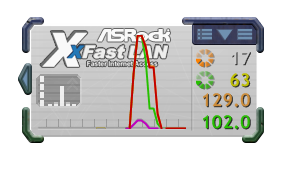
ASRock will start shipping a new software product with its products - XFast LAN. ASRock license this to be placed in its software portfolio, and lock it to ASRock motherboards. This software is actually produced by cFos Software GmbH, and based on cFosSpeed, a software solution for packet management (which retails at 16 euro), so that all outward bound packets are queued and those with highest priority are dispatched first, whilst maintaining high throughput. Without going into too much detail, it seems highly configurable and adaptive software to use. Whether it makes a significant difference to an end-user or consumer is to be determined, but ASRock are telling me they think it's better than a hardware solution, such as the Bigfoot Killer NIC.


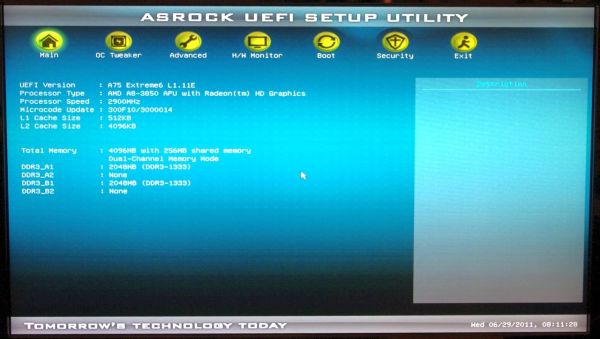
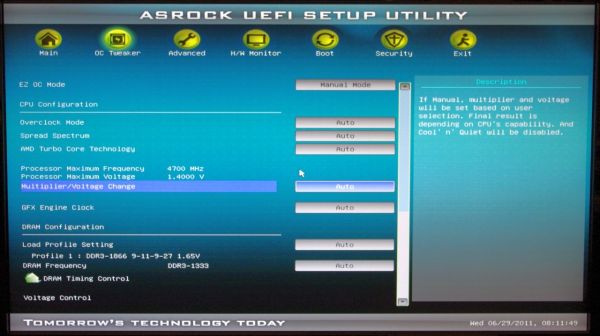
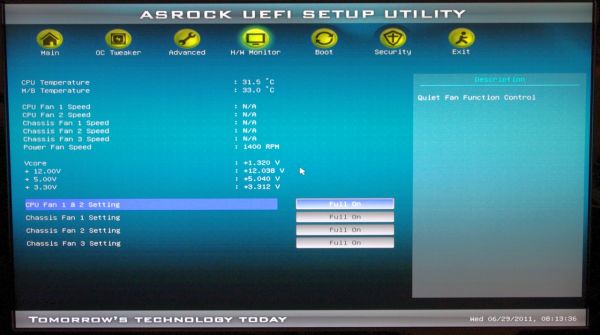






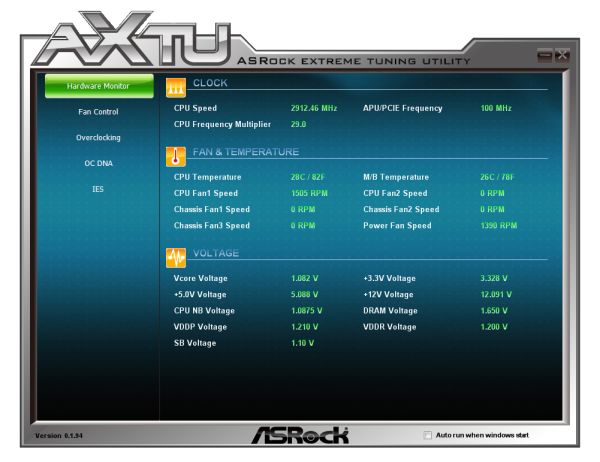
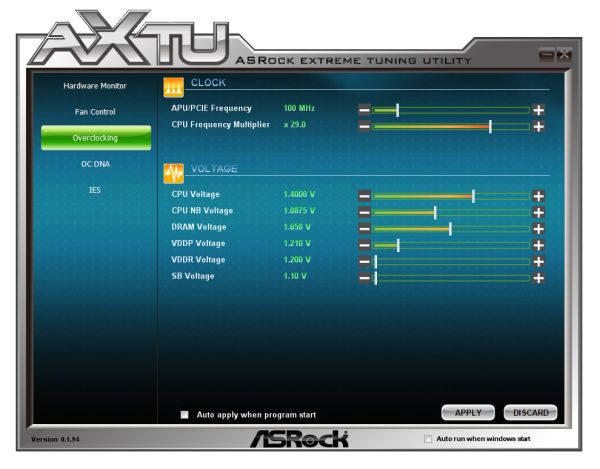









44 Comments
View All Comments
mino - Thursday, June 30, 2011 - link
"The question now becomes, is Desktop Llano worth the extra $75?"I keep wondering how much it cost to get you to claim Llano is 1/3 more expensive that i3 ?
REALLY ???
1) I do not remember you comparing _whole_platform_cost_ when reviewing Intel chips against AMD, at a time when there was a $30 Intel mobo tax in place.
2) Taking one of the highest-end Llano mobos with the highest-end Llano chip and comparing it price-wise to lowest-end SB (which it thoroughly trounces in everything besides single-threaded pure CPU loads) coupled to a low-end SB mobo? REALLY?
Shame.
L. - Thursday, June 30, 2011 - link
Eh .. sometimes bias is so visible, I'm not the only one to react anymore ;)But they do it every day... if anyone remembers the Xeon e7 review, where AT clearly showed that a 45nm Opteron was better in perf/watt than a 32nm Xeon ... biggest fail ever on the part of Intel that (they had same efficiency within 2% at full load, but reality is not full load :p ).
Even Tom's Hardware, which was Intel sponsored since the day it was sold wasn't even half as hard on the Llano as you guys ....
The one good info anyone can get out of this is that Intel is afraid of Llano and they're ready to pay a lot to get it slandered... one more reason to buy it, if Intel thinks it's great :)
whatthehey - Saturday, July 2, 2011 - link
No, you're not the only one to "react". You and all your asshole AMD luvin' fanboys from AMD zone or wherever are all over every one of the recent AMD articles on this site. Llano is an inexpensive APU that fails to impress. It's not bad, but for what it delivers? PLEASE!Overclocking? Intel wins by such a huge margin it doesn't even matter.
HTPC? Llano is buggy right now. Your best bet is a discrete GPU for serious HTPC use, and as long as you're getting a discrete GPU, you should buy the better CPU to go with it. Guess what, Intel wins again.
Gaming? Get a fucking clue, L. and duploxx. AMD has some great GPUs, but Llano is barely good for entry level gaming. No one that really cares about gaming is going to be impressed by something that matches a $35 dGPU.
General performance? Intel wins. Doesn't matter if it's SYSmark, PCMark, Sunspider, or some other test -- Intel has a substantially faster CPU architecture.
Pricing? Right now, AMD even loses this. Sure, you can get AMD systems for less than Intel systems, like if you get last-gen AMD. The Llano stuff right now is too expensive on the motherboard side to beat Core i3 and Pentium. When motherboard production ramps up, AMD and Intel will still be very nearly tied on pricing for low-end parts. Hooray!
3DMark. AMD wins in the IGP battle! Who cares about 3DMark? L. and duploxx and a bunch of other retarded AMD bigots who drink the AMD kool-aid and quote AMD PR like a bible.
In summary: everyone with half a brain can see the AMD Llano articles at Anandtech for what they are: factual representations of performance showing that AMD only wins on graphics, and only against IGP. Llano is only going to impress the dimwitted folks that slobber over every AMD release. Those who look for the best system will stay away, but I'm sure Best Buy will sell lots of these Llano systems to people that really have no idea what hardware is inside and don't care one way or another.
Snotling - Thursday, June 30, 2011 - link
"Tomorrow's technology today" they say... Seing as the Board has 3 "legacy" oh, no let me use "outmoded" PCI slots, I would call that "Yesterday's technology in store tomorrow"Who ever needs more than 1 PCI slot anymore? I can easily live with NONE.
But still they keep on designing boards with 2 and 3 of those... try finding a board with a 4x or 8x PCI-E for a RAID Add-on, almost non-existent unless you go for a server board.
This is supposed to be a higher end product for enthusiasts and I'm really NOT enthusiastic about NOT having a PCI-E 4x expansion on it.
dczyz - Thursday, June 30, 2011 - link
Just picked up a ASUS P8Z68-V PRO and was very disappointed with the lack of support for the Server 2008 based OS's.Since Server 08 is being used in Home Server, and Small Business I would like to see motherboard reviews cover compatibility for that.
mino - Thursday, June 30, 2011 - link
Server 2008 R2 is Windows 7 driver-wise. What more "compatibility" do you want?NOBODY is going to do server OS validation for you on desktop platforms for free. If you need that, go for a proper WS board.
Meaker10 - Friday, July 1, 2011 - link
So again you acknowledge the NB frequency option but ignore it?No look at if this helps performance?
enterco - Saturday, July 2, 2011 - link
The way see it, AMD Llano, used without a discrete GPU, is a good start-up platform for- multimedia management: USB3, SATA3 and quad core are strong points, enabling light video encoding tasks
- a kid's PC, who does not play yet 3D shooters.
Somewhere in this article I saw: "Metro 2033 is the Crysis of the DirectX 11 world (or at least until Crysis 2 is released)"
Ummm.... Crysis 2 sold here is not DX11 capable ? http://www.amazon.de/Crysis-2-Limited-Edition-uncu...
puretech - Saturday, July 2, 2011 - link
"with up to 2x the performance of the highest version of Intel's integrated graphic solutions of the Sandy Bridge second generation Core series."A very statement statement considering all tests last two days show 2 - 6 times higher performance, with drivers and programs (and BIOS) yet to be tuned for the Fusion platform.
whatthehey - Sunday, July 3, 2011 - link
Horse shit. What is it with all the AMD crazies? Llano's IGP is on average about twice as fast as HD 3000, unless you test with a few specific games. Anything OpenGL pretty much tanks on Intel, but the number of current OpenGL titles that people play is quite small... Minecraft is probably the best example. Let's take a few of the major sites.Tom's Hardware:
Metro 2033: Llano is about 2x faster than HD 3000
Call of Duty Modern Warfare 2: Llano is twice as fast, give or take (depending on settings)
World of Warcraft: Llano is twice as fast, give or take.
AnandTech:
Crysis: Warhead: Llano is about twice as fast
Metro 2033: Less than twice as fast
HAWX: Less than twice as fast
Civilization V: About three times as fast (one of the few cases where we see more than a 2x increase)
DiRT 2: About 2.5x as fast
Mass Effect 2: Less than twice as fast
StarCraft II: usually less than twice as fast
Legit Reviews:
Resident Evil 5: Less than twice as fast
HAWX 2: about 2.5x as fast
STALKER Call of Pripyat: about twice as fast
PC Perspective:
Civ V: Tied with the HD 3000 in the i7-2600K
DiRT 3: about 2.5x compared to HD 2000
Left 4 Dead 2: Less than twice as fast
StarCraft II: about 2x
So that's four major sites and the highest lead by Llano in graphics is only 3x -- nowhere near the 6x you claim. On average, 2x lead compared to the i3-2105 looks about right, and if you put in an HD 6670 -- which is really the bare minimum for anyone that actually wants to play games -- you get double the performance of Llano. OMFG! That's amazing! Let's all praise AMD for delivering an IGP that can perform half as fast as what mainstream gaming actually needs!
GTFO. I'm sick of all the AMD crybabies. Llano is mediocre on desktops at best. It's better on a laptop, but only for medium detail 720p gaming. To pretend that medium detail 720p is more important than all the other aspects is stupid. But then, no one ever said fanboys were smart.